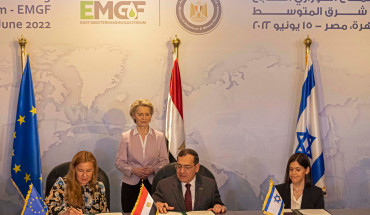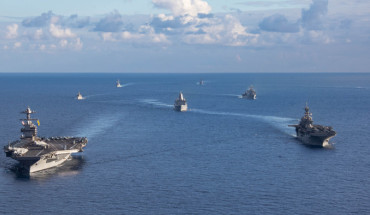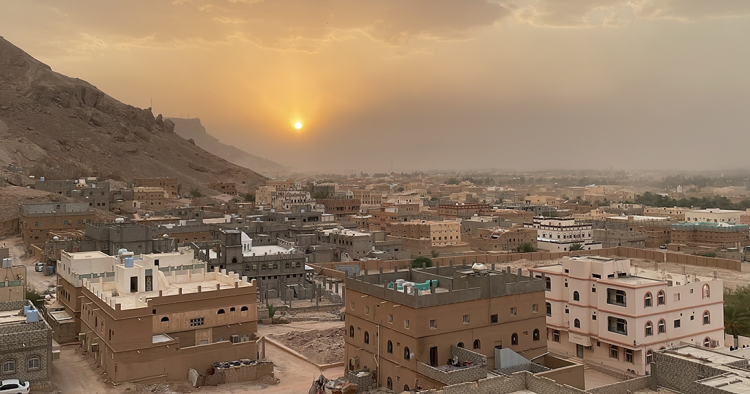Yemen’s eastern governorate of Hadramawt has long had a distinct regional identity and recent steps, including the signing of a Hadrami Honor Charter and the formation of the Hadramawt National Council (HNC), have underscored Hadramis’ aspirations for greater empowerment and autonomy at a time of growing competition and contestation, both locally and regionally.
On Nov. 28, 2023, the chairman of the HNC’s founding committee, Badr Ba-Salmah, announced a significant step forward with the formation of a 23-person presidium for the Council and the completion of internal organizational documents. This came nearly five months after the conclusion of intra-Hadrami talks in Riyadh in June 2023, when a group of leading local figures announced a Hadrami Honor Charter to support local aspirations and declared its intent to establish the HNC. Held upon Saudi invitation, the Riyadh talks lasted for nearly a month, running from late May to late June, and included Hadrami politicians, military officials, intellectuals, tribal sheikhs, and social figures. The discussions aimed at developing a unified Hadrami position ahead of comprehensive peace talks and covered the future of the region amid increasing rivalry.
Although these latest moves underline Hadrami aspirations for empowerment under the slogan “Hadramawt first,” the effort to establish a regional umbrella platform comes against the backdrop of growing competition from the Southern Transitional Council’s (STC) secessionist project and a widening divergence between Saudi and Emirati visions and ambitions. While the lack of strategic engagement and direction in Yemen appears to be an enduring feature of wartime domestic politics and regional involvement, the HNC has yet to face its first test on the ground.
Hadramawt first
The June 2023 Hadrami Honor Charter, signed by 86 figures, prioritized “Hadramawt’s supreme interests” above factional, political, and personal ones; tasked a committee, led by former Transport Minister Ba-Salmah, with drafting a constitution and a developing an internal structure within two months; and emphasized the importance of the cohesion and unity of Hadrami decision-making. The announcement of the presidium and internal structure, however, was delayed by three months and was rolled out as Saudi-Houthi talks entered an advanced stage, according to reports. The HNC is expected to establish a supreme body comprising 351 members and complete the Council’s structure.
While the creation of the HNC does not replace existing Hadrami movements and instead endeavors to serve as a coordinating umbrella for Hadrami ambitions, the immediate resignation of Sheikh Amro bin Hibreesh, chief of the Hadramawt Inclusive Conference, from the presidium indicates the need to hold regular talks to secure greater local buy-in. Among the HNC’s ranks are established former officials (like Saad al-Din bin Talib), influential sheikhs (Sheikh Yahya Bajeri), and academics (Abdulqader Bayazeed and Fahmi Fararah), although the exclusion of some political and tribal figures appears notable. It is also worth noting that the call for prioritizing “Hadramawt first” is not new. Sheikh Yahya Bajeri held previous discussions with Hadrami socio-political networks earlier in 2023 and even announced a separate charter along similar lines in mid-May, all of which went on to inform the honor charter signed in June.
Hadramawt’s importance stems from its rich cultural, historical, economic, and geographic foundations. The region has been home to independent states in the past, like the Hadramawt Kingdom (from 1100 BCE until the third century CE), while in modern times it has been the largest governorate not only in the People’s Democratic Republic of Yemen (South Yemen, PDRY) but also in the unified Republic of Yemen. The governorate accounts for more than one-third (36%) of the republic’s territory, shares over 600 km of borders with Saudi Arabia, and has been the country’s top oil producer since additional discoveries were made in the 1990s. Before the conflict intensified in 2014, the governorate produced at least 104,000 barrels per day (bpd) of oil, accounting for over one-fifth of Yemen’s total output of approximately 470,000 bpd. In more recent years, until the Houthis launched an economic embargo targeting oil and gas export facilities in government-held areas in October 2022, Hadramawt contributed more than half of the government’s production of 50,000-60,000 bpd of exportable crude oil.
Agriculturally, Hadramawt’s coast (al-sahel) and valley (al-wadi) regions are home to fertile land that produces wheat, barely, dates, and citrus fruits, supporting domestic food production. The governorate also has a dynamic fishery sector given its location along the Arabian Sea, providing livelihoods for residents and a basis for export-oriented businesses. Al-Mukalla is the main city in the coastal region, while Seiyun and Tarim are the primary cities of the valley. The governorate’s coastline is also home to several key ports, with al-Shihr serving as one of three major crude oil loading terminals. Hadramawt’s location between Saudi Arabia and Oman and overlooking the Arabian Sea and the Indian Ocean has long facilitated commerce and cultural exchange on the Arabian Peninsula, East Africa, Southeast Asia, and beyond. The Hadrami diaspora outside of Yemen is large, estimated at around 14 million, chiefly in the Gulf, East Africa, and Southeast Asia, members of which have risen to prominence as ministers, governors, and business leaders. Religiously, Hadramawt has a large Sufi presence in Tarim, where thousands of foreign students continue to study today, as the author saw during a recent trip. Hadramawt's social, economic, political, and cultural heft, coupled with its geographic size, makes the governorate strategically important, especially for controlling southern Yemen.
The HNC: Context and motives
The HNC was formed against the backdrop of growing competition and rivalry on both the regional and local levels. Regionally, Saudi Arabia’s latest moves in eastern Yemen reflect not only its long-standing policy in Hadramawt but also the Saudi-Emirati divide on a number of key files, including Yemen. For Saudi Arabia, maintaining a sphere of influence across its long shared border with Hadramawt is a strategic imperative, the importance of which is shaped by geography, strategic depth, people-to-people relations, culture, history, trade, and geopolitics.
Domestically, Hadramis have a strong sense of local identity and aspirations for, at a minimum, autonomy beyond the existing structure of the state, either at present or as it was under the PDRY. The HNC’s announcement, aimed at unifying a wide range of Hadrami movements championing, at a minimum, greater autonomy and an equitable share of resources and power, came at a time when the STC is expanding its presence and influence. The STC has advocated for secession and recently organized an intra-southern dialogue that ended with it consolidating power and absorbing several figures from other southern movements into its ranks, including Presidential Leadership Council (PLC) member Faraj al-Bahsani, Hadramawt's former governor, who it co-opted and made a vice-president.
Internally, the formation of the HNC signals increasing discontent about the STC’s aspirations for eastward expansion as well as its broader secessionist project, aimed at restoring the PDRY along the 1967-1990 borders. Hadrami demands for greater autonomy and equitable power-sharing and distribution of wealth are also based on long-standing historical grievances, both under the current republic as well as before and during the PDRY. These have been amplified by four major recent triggers: first, the approach adopted in the STC-led south-south dialogue; second, the arrival of STC chief Aidarous al-Zuabidi, who is also a member of the PLC, in a large military convoy in al-Mukalla on May 18, 2023; third, the decision to hold the 6th session of the STC’s assembly in al-Mukalla regardless of the level of buy-in; and fourth, the deployment of pro-STC militant groups along Hadramawt’s coast and in the valley. The latter in particular revived old insecurities and grievances in far eastern Hadramawt over issues like the PDRY’s political violence or nationalization of assets. The STC’s small recent protests and mobilizations in al-Mahra, al-Mukalla, and Seiyun, as well as pro-STC journalists’ critical views of the HNC, have only exacerbated matters and suggest that if the situation is not addressed carefully through dialogue, military escalation cannot be ruled out. The STC hopes to leverage the support of the two southern separatist movements (or Hirak) of Ali Salim al-Beidh and Hassan Ba’oum, who have been activists to varying degrees for over 18 years, although it is unlikely to reverse military recruitment and deployments easily.
A large section of Hadramis now seek an alternative not only to secession, but also to the unitary shape of the state that former President Abed Rabbo Mansour Hadi had wanted to address in 2014 by adopting federalism. Put differently, Hadramawt is at crossroads, caught between competing political projects, including the STC’s bid for secession, the Yemeni government’s inchoate federalism, and the Houthis’ backward, extractive unitary state. Additionally, the exclusion or non-engagement of Hadrami PLC member Bahsani also raises questions about whether he “represents the governorate through a ‘Hadramawt first’ approach or the STC,” as a Hadrami political analyst told MEI. It is worth noting, however, that the Hadrami Elite Forces (HEF) and Hadramawt Governorate under Bahsani avoided engaging in government-STC conflicts in 2019 and 2020, including when the STC declared self-administration before Bahsani joined its ranks as a deputy chief.
Amid the growing polarization, the president of the PLC, Dr. Rashad al-Alimi, met with Hadrami figures in late June in Riyadh who, as he put it, “embody the spirit of responsibility in distancing their governorate and liberated areas from any conflicts,” before visiting the governorate a few days later in a show of support. Alimi then announced his backing for autonomy in Hadramawt — an effort he said he hopes will be “a pilot model for decentralization” — and rolled out a SAR 1.2 billion ($320 million) package of projects and programs, supported by Saudi Program for the Development and Reconstruction of Yemen.
Externally, the Saudi-hosted Riyadh talks in mid-2023 came amid a growing Saudi-Emirati split on several regional files, including Yemen. Saudi Arabia’s shift to supporting local councils appears to be an attempt to develop pockets of support, reshape the power equilibrium, and balance against potentially unfavorable developments. Due to Saudi Arabia’s geographical proximity, deep people-to-people relations, and geopolitical interests, Riyadh has attempted to carefully balance and curtail both Abu Dhabi’s growing influence and the secessionist project championed by the STC. The announcement of the HNC’s presidium in November with the republic’s flag behind the podium made this clear, as have attempts to gradually redeploy the Saudi-supported National Shield Forces in Hadramawt.
Currently, the provision of security in Hadramawt is mixed and reflects the overall landscape. The HEF, a local force of up to 30,000 trained, financed, and armed by the UAE, is in charge of providing security along the coast up to the borders of al-Mahra and Shabwah governorates. Although al-Dhabba Port has been inactive due to Houthi drone attacks in 2022, the HEF, citing security reasons, keeps the main coastal road between Shihr and al-Mukalla closed between midnight and 6:00am, forcing people and goods to travel an additional hour through Gail Bawazir. The First Military Region, an administrative area covering the valley and inland parts of al-Mahra Governorate whose units have received support from Riyadh, controls those areas.
What’s next?
While the HNC’s ultimate motives, strategy, and vision are not yet clear, it is hoped that it will emerge as an inclusive umbrella for coordination between Hadrami movements, unlike the STC, which has attempted to consolidate a wide range of southern entities under its leadership. The rollout of the Hadrami Honor Charter provided an inclusive, consensual foundation for collaboration with the HNC and the process was notable for both its practical successes and its ability to address flaws as they emerged. The subsequent delay in the HNC’s announcement of internal guidelines as well as a constitution, structure, and vision demonstrates the limits of tactical engagement but also raises questions about the group’s strategic direction and resources.
It remains unclear whether Hadrami or Saudi Arabian money will finance the HNC and whether it will be a peaceful political entity or have a military wing, given the hybrid nature of other political projects across the country. It is also unclear, given the multiplicity of Hadrami social and political movements, how the public figures who belong to more than one of them will carry out their roles and responsibilities, not to mention how the HNC will coordinate among the various movements, provided there is adequate buy-in, including from the Hadhramawt Inclusive Conference’s top leadership. While the level of public support for the HNC remains to be seen, the STC, which now has at least 26 member groups, including the southern movements of Beidh and Ba’oum, has been cautiously watching developments, assessing the implications and potentially recalibrating its approach.
This complex, uncertain landscape has several implications for Hadramawt and beyond. First, Hadramis will have to undergo a test of unity given the degree of competition, economic inducement, and rivalry, both domestically and regionally. Second, there is a dire need to closely monitor conflict triggers, pillars of de-escalation, and military redeployments to develop early warning and conflict avoidance mechanisms to maintain peace and stability locally. Third, the STC should not be underestimated given its objectives and quest for influence. The group should avoid pushing ahead with military expansion to Hadramawt and triggering past grievances, both age-old and more recent, lest it risk losing the battle for local hearts and minds. This is not to mention the fact that its failure to develop a security and service delivery model in Aden has raised questions about what it can offer the public, even mindful of resource disparity. Fourth, for Hadramis to ensure representation in any comprehensive peace process, they should first aim to strengthen the HNC as a coordinating umbrella — or any other consensual alternative — by gaining the endorsement of the majority of, if not all, major Hadrami movements. Fifth, the creation of regional councils, as seen in the announcement of the Eastern Council in January 2024, is likely to result in a greater focus on identity-based politics and efforts to ensure more equitable access to opportunities, wealth, and power. For Hadramis, however, the biggest test will be to answer the question of whether the HNC is a strategic and proactive move or a reactionary one against the backdrop of growing domestic and regional competition.
Ibrahim Jalal is a Yemeni security, conflict, and defense researcher; a Non-Resident Scholar at MEI; and a co-founding member of the Security Distillery Think Tank.
Photo by Ali Ebubekir Tokcan/Anadolu Agency via Getty Images
The Middle East Institute (MEI) is an independent, non-partisan, non-for-profit, educational organization. It does not engage in advocacy and its scholars’ opinions are their own. MEI welcomes financial donations, but retains sole editorial control over its work and its publications reflect only the authors’ views. For a listing of MEI donors, please click here.













